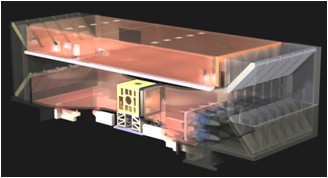 |
 |
 |
| POLIMI's wind tunnel | Test room | Wind tunnel model |
ACARE with its strategic road map stated in the Vision 2020 confronts aircraft industry with the demands for significantly greener aircraft with a substantial reduction of fuel consumption, emissions and perceived noise levels. These new greening requirements cover all the components of the aerospace field, including fixed wing large transport aircraft, regional aircraft, engines and helicopters. One of the most promising concept regarding more environmentally friendly aircraft concerns Natural Laminar Flow (NLF) wing. This concept requires a fully multidisciplinary approach due to the counteracting role of main aircraft parameters such as wing swept, wing thickness and cruise speed, so to minimize the potential structural wing penalty.
Aiming at this global target, a possible solution is based on combining Natural Laminar Flow (NLF), that could be obtained by an aggressive combination of manoeuvre (MLA) and gust load alleviation (GLA) technologies that holds the potential to greatly improve both the weight and aerodynamic terms in the classical Breguet equation. For all these reasons the interest in the development, implementation and experimentally verification of MLA and GLA technologies is becoming a key topic in the development of the next generation transport aircraft.
The GLAMOUR project, in response to the SP1-JTI-CS-2013-01-GRA-02-022 call, tackles this topic in two different ways. At first, having the Green Regional Aircraft as reference, starting from the active control lows proposed by ITD member, it tries to deeply explore their validity over the entire flight envelope. In particular, different control strategies will be investigated, based on the use of Static Output Feedback, Neural Networks, Robust Model Predictive Control techniques, as well as based on Local Direct Control.
Then, an extended experimental validation campaign will be conducted at Wind Tunnel available at Politecnico di Milano. A large wind tunnel half aircraft model properly scaled will be manufactured and tested in a free-free configuration allowing to validate MLA and GLA techniques based on coupling wing and tailplane based control surfaces under gust excitation. Aiming at this goal, a dedicated gust generator will be designed, manufactured and installed into the wind tunnel.
The GLAMOUR project appears as especially challenging for two main reasons. At first for the complexity of the model to be tested, i.e. a complete aeroelastic model, fully instrumented so to measure the relevant aeroelastic responses (accelerations, displacements, section loads, actuation forces) by means of embedded sensors as well as external optical measurement systems, and equipped with different control surfaces. On the other hand, for the test conditions to be investigated, allowing for a deep validation of proposed MLS and GLA concepts in a very realistic flight environment.
To synthesize, the main goals of GLAMOUR projects are the following:
 |
 |
 |
| POLIMI's wind tunnel | Test room | Wind tunnel model |